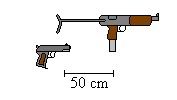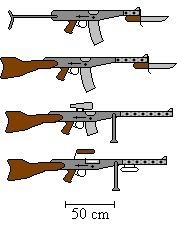CDF small arms
Small arms are the personal firearms used by soldiers, not heavy weapons like artillery or tanks. The Land Service of the Community Defence Forces of Sober Thought uses a variety of such weapons to arm its members while they are performing their military duties.
Small arms divide roughly into three groups: those firing pistol ammunition, those firing rifle ammunition and those firing machine gun ammunition. Military pistol ammunition has more or less standarised worldwide at 9 mm. However, other standards have proved problematic. While alliance discussions may alter the rifle calibre to conform to a different standard such as 5.56 mm (.219 or .22 inch) or 7.62 mm (.30 inch), the basic design of the weapons will remain unchanged. Similarly, the machinegun calibres are somewhat malleable though their designs are less so.
Pistol ammunition weapons
|
|
|---|
Officers and some technical staff are armed with 9 mm pistols with 10 round clips, and follow a fairly conventional design reminiscent of the real world Browning 9 mm, Colt .45 inch and Glock .40 inch pistols. They serve more of a ceremonial or theoretical role on the modern battlefield, since their accurate range is less than 50 metres.
The same ammunition, but loaded into twenty or thirty round magazines, is fired from submachine guns looking somewhat like a RL Uzi or Ingram with the clip fitting into the pistol grip. These SMGs, with an effective range of about 100 metres, are used to equip other technical staff, naval boarding parties, urban light infantry and other combat soldiers who fight in places where space is at a premium, accuracy is unimportant and range is short.
Rifle ammunition weapons
|
|
|---|
The most numerous group by far is the 7 mm long arms family consisting of carbine, assault rifle, sniper rifle and light machinegun variants. They have the general outward appearance of a PPSh 43 or AK 47, and all of them can be fed by 15 or 30 round magazines.
Carbines are similar to submachine guns in role. They have collapsible wire stocks because they are issued to troops who normally operate a vehicle or operate in enclosed spaces. Unlike the SMGs, they can fix a bayonet on the end of the barrel. Although the military utility of this is slim, it does give the combat knife a dual role.
The assault rifles are most similar to carbines, except they have somewhat longer barrels and fixed stocks. They are typically issued to infantry who normally operate on foot, whether they are delivered to the battlefield by motor or foot power. The assault rifle is by far the most common small arm issued.
Snipers need a fixed stock like the mass of infantry – for steady aim rather than for robustness – but a telescopic sight rather than a mechanical one. A much longer barrel and a swivelled bipod increase both accuracy and range.
A light machine gun is issued to every infantry squad, and normally the No. 2 carries several 100 round ammunition belts and the No. 1 uses the carrying handle before taking up position. The same bipod as the sniper rifle provides a modicum of stability. The barrel length is between that of the rifles, a handle underneath creating a quick-change capability.
Machinegun ammunition weapons
|
|
|---|
The Community Defence Forces' medium and heavy machineguns uses ammunition with an explosive charge greater than that of the 7 mm long arms. They resemble the Browning machinegun family but each calibre has identically sized ergonomic pistol-grip triggers and barrel grips.
The basic design for both is a stockless receiver with hinged access for loading 200 round belts of bullets, a yoked pin closed by a cotter pin for affixing to mounts, a round fixed sight and a quick-change barrel. However, the 8 mm MMG is one third smaller than the 12 mm HMG. In addition to being used by infantry, machineguns are often mounted on tanks, other armoured vehicles and softskinned vehicles.



